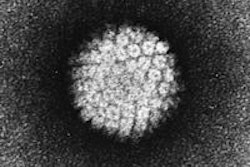
Less intense treatment of low-risk HPV-related oropharyngeal cancer can achievegood patient outcomes with less toxicity, according to a presentation on October 19 at the recent American Society for Radiation Oncology (ASTRO) annual meeting in San Antonio.
 Bhishamjit Chera, MD. Image courtesy of Brian Strickland.
Bhishamjit Chera, MD. Image courtesy of Brian Strickland.A group of favorable-risk patients remained cancer-free after receiving lower treatment doses. Presented at the ASTRO meeting before publication, the study supports prior research that such patients have better responses to chemoradiotherapy and better prognoses than patients with HPV-negative cancer (International Journal of Radiation Oncology, Biology, Physics, November 1, 2015, Vol. 93:3, pp. S172-S173).
"Our study provides strong preliminary evidence that deintensification in carefully selected favorable risk oropharyngeal cancer may be efficacious," lead study author Bhishamjit Chera, MD, told DrBicuspid.com. Dr. Chera is an associate professor in the department of radiation oncology at the University of North Carolina School of Medicine.
Rising rates
The incidence of HPV-positive oropharyngeal squamous cell carcinoma increased 225% from 1988 to 2004 (from 0.8 per 100,000 to 2.6 per 100,000), according to a June 2015 study in Clinical Cancer Research. If this trend continues, the annual number of HPV-positive oropharyngeal cancers is expected to surpass the annual number of cervical cancers by the 2020.
Some theories for the increase include changing sexual mores (more oral sex, more promiscuity) and an increased use of marijuana, which causes immunosuppression in the tonsils and base of tongue, thus increasing susceptibility of infection of these areas, according to Dr. Chera.
"But no one really knows for sure," he said.
The number of such cases is expected to rise significantly over the next decades because of a lack of a screening paradigm and despite the availability of a prophylactic vaccine, according to a 2011 study in the Journal of Clinical Oncology (November 10, 2011, Vol. 29:32, pp. 4294-4301).
Research shows that the incidence of certain types of head and neck squamous cell carcinomas are increasing, especially among young adults. Patients with HPV-positive tumors have a significantly improved prognosis, but the disease advances in as many as 25% of such cases after treatment, most within the first two years.
The biomarker of HPV type 16 (HPV16) DNA in oral exfoliated cells is detected in up to two-thirds of HPV-positive oropharyngeal cancer cases before treatment, the Clinical Cancer Research study showed. HPV16 antibody status is a strong predictor of survival among patients with HPV-positive oropharyngeal squamous cell carcinoma, the researchers found. Specific antibody status can be used to identify patients with HPV16-positive tumors who may benefit from altered monitoring and treatments.
Less is more
In this small, prospective, multi-institutional clinical study, researchers followed 43 patients (38 men and 5 women; 91% of participants reported as white with an average age of 61). All patients had favorable-risk (lower level tumors), HPV- or HPV16-positive oropharyngeal squamous cell carcinomas and a minimal smoking history (82% had never smoked).
“Our study provides strong preliminary evidence that deintensification in carefully selected favorable risk oropharyngeal cancer may be efficacious.”
The patients received weekly doses of 60 Gy of radiation for six weeks and the chemotherapy drug cisplatin. The regimen represented a 10-Gy reduction in the usual radiation dose and a 40% reduction in the usual chemotherapy dose, Dr. Chera said.
Overall, 86% (37 of 43 patients) had no evidence of cancer in their biopsy or surgical specimens after receiving the lower-intensity chemotherapy and radiation treatment, the study found. The other six patients had microscopic residual foci of unknown significance that was removed in the planned biopsy and limited neck dissection. The results were virtually identical to historical rates achieved with standard regimens, the study authors noted.
All 43 patients were alive with no evidence of cancer recurrence at follow-up (median follow-up 20 months).
The study also found less acute side effects under the lower treatment regimen.
New standard of care?
Further study of deintensified chemoradiotherapy in such patients is needed, Dr. Chera said. "Likely in the future, deintensified chemoradiotherapy may become the new standard of care (after appropriate further study in clinical trials, with more patients and longer follow-up)," he concluded.



















